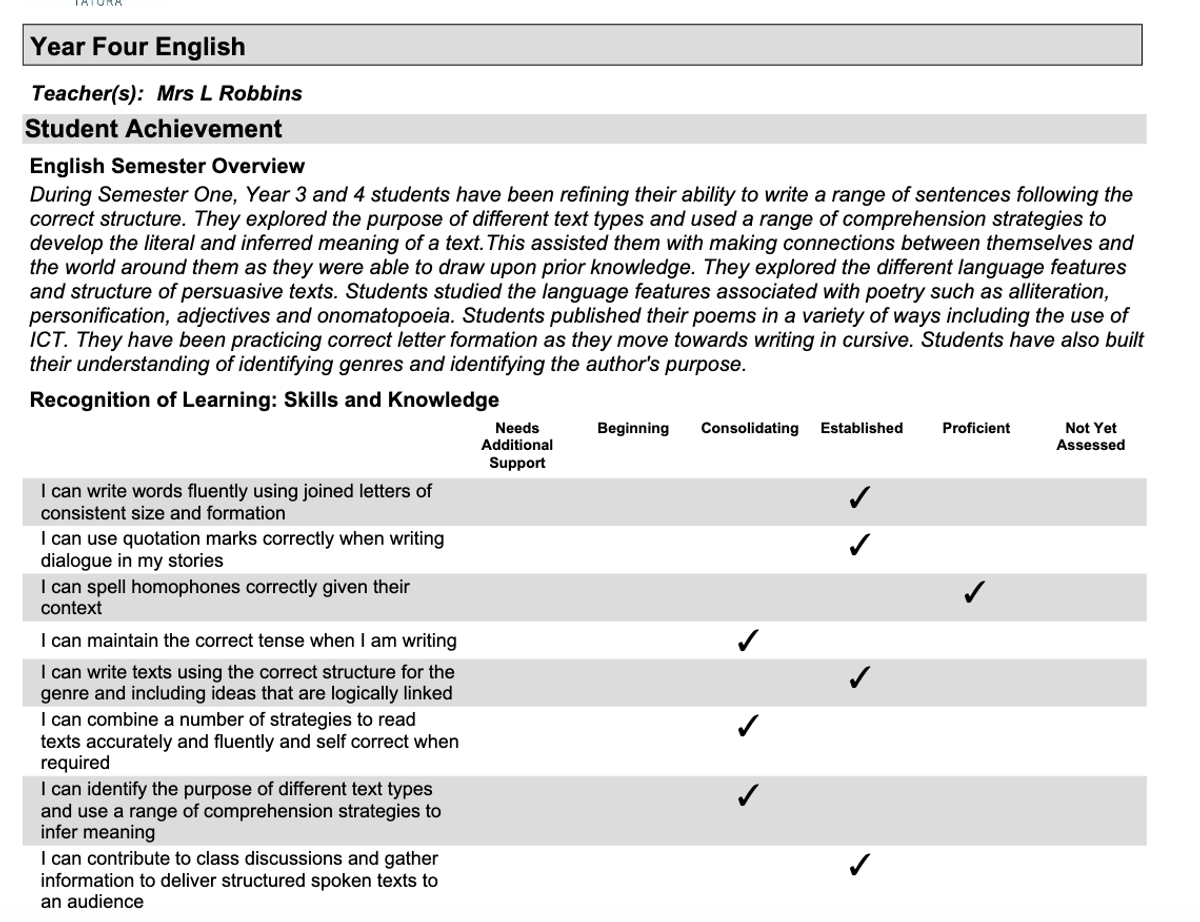Semester Reports

NEW LOOK STUDENT ACHIEVEMENT SEMESTER REPORTS ARE COMING
The Victorian Registration and Qualification Authority (VRQA) along with the Victorian Curriculum and Assessment Authority (VCAA) set out minimum guidelines for schools regarding reporting on student learning. Student assessment reports are designed to give parents an understanding of their child’s progression in learning and their ability in relation to the expected standard for their age. Schools are required to issue a minimum of two Student Assessment Reports per year, one in each half of the year.
At Sacred Heart, we value parent input regarding communication about our children. This year, we have begun to design a ‘new look’ report that we hope gives parents a more detailed understanding of their child’s achievement and progress. Over the coming weeks we will release information regarding the content of these reports and how to read, understand and discuss them with your child’s teacher.
VICTORIAN CURRICULUM STANDARDS
This part of the Student Report sets out where teachers have assessed your child’s achievement in relation to the expected standard for their year level.
The left hand side states the curriculum area (‘subject’) and in the case of English and Mathematics, the ‘strands’ or how the standards and content is grouped. Semester 1 reports assess the areas of English, Mathematics and Geography (Yr 2-6). Semester 2 reports will include all curriculum areas.
The middle of the table represents where the teacher has assessed your child’s understanding in relation to what is expected for their year level.
- A circle with P (Previous Judgement ) in it represents where your child was when they were last reported on in that curriculum area. Note: this could be anywhere from the last student report (6 months ago) or in some areas, 2 years ago - depending on the subject area.
- A circle with C (Current Judgement) in it represents where your child’s teacher believes their current level of understanding is in relation to what is expected for their year level.
- A circle with N (No progress) in it is indicative that, while your child may have consolidated their understanding since their previous report, they have not made enough progress to meet the expectation of the next level.
- The filled in circles represent all the previous judgements for that particular curriculum area during the student’s time at Sacred Heart.
The red line, shows the expected standard for the year level.
The right hand side of the table shows whether your child is ‘at’, ‘above’ or ‘below’ the expected standard. Please note, in recognition that there can be a wide age range in one year level, a child who is marked 6 months below the expected level, is still regarded as ‘at standard’.
APPLICATION TO SCHOOL LIFE
Along with our Mercy and Gospel Values, our PBIS expectations create the foundation for fostering a safe and inclusive learning environment. These are broken down into statements and judgements indicating whether the student follows these expectations ‘consistently’, ‘usually’, or ‘sometimes’, or if they ‘need additional support’ in the area.
APPLICATION TO LEARNING
Students at Sacred Heart are encouraged in and taught a number of attributes that contribute to their own learning and the learning of their classmates. The development and consistent application of these assist in them becoming self directed and active learners. This Semester, these will be shown for English, Mathematics, Religious Education, Physical Education, Visual Art, Library and Music as an indication of how your child engages in these areas of learning. They will indicate whether your child displays the attribute ‘consistently’, ‘usually’, ‘sometimes’ or whether they ‘need additional support’ in this area. Below is an outline of why we value these attributes as an important part of being an active and effective learner.
| Demonstrates a positive attitude to their learning | A positive disposition to learning assists students to develop their confidence and self belief when faced with challenging tasks. |
| Ask questions to clarify their understanding | The ability to ask questions when learning is an indication of an inquiring and thinking mind. When students understand that questioning assists in learning, they develop their ability to monitor their own understanding of content and processes. |
| Takes responsibility for their learning | Taking responsibility for learning assists students to become more independent and self directed. It involves the ability to be organised with their learning tools, manage their time, and complete tasks to the best of their ability. |
| Shares their thinking with their teacher and class group | The ability to express their thinking is an indication that students’ are developing their awareness and understanding of their own thought processes. Students are encouraged to express their ideas and share them with their teachers and peers. |
| Works collaboratively with others | Being an effective team member requires the ability to collaborate with others. Students are encouraged to work respectfully, communicate effectively and problem solve when working in groups. |
| Respects the learning of others | Our school is an environment where we have high expectations for the learning of all. Students are encouraged to understand the importance of respecting the rights of their peers to learn without distractions or interruptions. |
RECOGNITION OF LEARNING: SKILLS AND KNOWLEDGE
This semester, for the curriculum areas of English and Mathematics, parents will be given an indication of their child’s level of understanding in specific skills expected for their Year Level. Teachers will indicate if your child ‘needs additional support’, is ‘beginning’, ‘consolidating’ ‘established’ or ‘proficient’ in regard to the skill. It is very important to note that these skills are the expectation for the END OF THE YEAR. Therefore, for Semester 1:
- ‘Needs Additional Support’ indicates that the student is not yet ready to learn this skill as there may be prerequisite skills that are not yet established in order for them to begin this part of learning.
- ‘Beginning’ indicates that the student is just beginning to show this skill but still requires further explicit teaching in the area
- ‘Consolidating’ indicates that the student is showing that they have the expected level of understanding of the skill for this time of the year and are on track to meet the year level expectation for the end of the year.
- ‘Established’ indicates that the student has learnt this skill and is showing it consistently in their work. Their achievement of this skill is six months ahead of our expectation.
- ‘Proficient’ indicates that the student has this skill very well established and is working beyond their year level expectation.
- ‘Not Yet Assessed’ indicates that this element has not been explicitly taught this semester and will be addressed in Semester Two
Although this is a new element in our reporting, for most students there is an expectation that the students have met the previous year level expectations. As such, a PDF of the Skills and Knowledge elements for all year levels in English and Mathematics will be made available with the report, via SIMON. You may refer to these to gain an understanding of the progression of learning throughout the year levels.
If you have any further questions or would like more information about the reporting format, please feel free to contact me.
Loretta Robbins
Leader of Curriculum and Pedagogy




